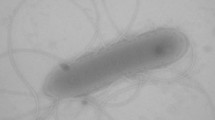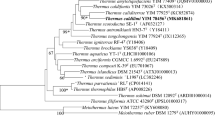Abstract
A novel thermophilic, alkali-tolerant, and CO-tolerant strain JW/WZ-YB58T was isolated from green mat samples obtained from the Zarvarzin II hot spring in the Uzon Caldera, Kamchatka (Far East Russia). Cells were Gram-type and Gram stain-positive, strictly aerobic, 0.7–0.8 μm in width and 5.5–12 μm in length and produced terminal spherical spores of 1.2–1.6 μm in diameter with the mother cell swelling around 2 μm in diameter (drumstick-type morphology). Cells grew optimally at pH25°C 8.2–8.4 and temperature 50–52°C and tolerated maximally 6% (w/v) NaCl. They were strict heterotrophs and could not use either CO or CO2 (both with or without H2) as sole carbon source, but tolerated up to 90% (v/v) CO in the headspace. The isolate grew on various complex substrates such as yeast extract, on carbohydrates, and organic acids, which included starch, d-galactose, d-mannose, glutamate, fumarate and acetate. Catalase reaction was negative. The membrane polar lipids were dominated by branched saturated fatty acids, which included iso-15:0 (24.5%), anteiso-15:0 (18.3%), iso-16:0 (9.9%), iso-17:0 (17.5%) and anteiso-17:0 (9.7%) as major constituents. The DNA G+C content of the strain is 45 mol%. Phylogenetic analyses based on 16S rRNA gene sequences revealed that strain JW/WZ-YB58T is distantly (<93% similarity) related to members of Bacillaceae. On the basis of 16S rRNA gene sequence, physiological and phenotypic characteristics, the isolate JW/WZ-YB58T (ATCC BAA-1258; DSM 17740) is proposed to be the type strain for the type species of the new taxa within the family Bacillaceae, Thermalkalibacillus uzoniensis gen. nov. sp. nov. The Genbank accession number for the 16S rRNA gene sequence is DQ221694.



Similar content being viewed by others
References
Blum JS, Bindi AB, Buzzelli J, Stolz JF, Oremland RS (1998) Bacillus arsenicoselenatis, sp. nov., and Bacillus selenitireducens, sp. nov: two haloalkaliphiles from Mono lake, California that respire oxyanions of selenium and arsenic. Arch Microbiol 171:19–30
Claus D, Berkeley RCW (1986) Genus Bacillus cohn 1872. In: Sneath PHA, Mair NS, Sharpe ME, Holt JG (eds) Bergey’s Manual of Systematic Bacteriology. Williams & Winkins, Baltimore, pp 1105–1139
Conrad R (1996) Soil microorganisms as controllers of atmospheric trace gases (H2, CO, CH4, OCS, N2O and NO). Microbiol Rev 60:609–640
Cook GM, Keis S, Morgan HW, van Ballmoos C, Matthey U, Kaim G, Dimroth P (2003) Purification and biochemical characterization of the F1FO-ATP synthase from thermoalkaliphilic Bacillus sp. strain TA2.A1. J Bacteriol 185:4442–4449
Cypionka H, Meyer O (1982) Influence of carbon monoxide on growth and respiration of carboxydotrophic and other aerobic organisms. FEMS Microbiol Lett 15:209–214
Demharter W, Hensel R (1989) Bacillus thermocloaceae sp. nov, a new thermophilic species from sewage-sludge. Syst Appl Microbiol. 11:272–276
Dunfield KE, King GM (2004) Molecular analysis of carbon monoxide-oxidizing bacteria colonizing recent Hawaiian volcanic deposits. Appl Environ Microbiol 70:4242–4248
Garrity MG, Bell JA, Lilburn TG (2004) Taxonomic Outline of the Prokaryotes. Bergey’s Manual of Systematic Bacteriology, second edition, release 5.0 May 2004. http://141.150.157.80/bergeysoutline/outline/bergeysoutline_5_2004.pdf
Gee DL, Brown WD (1980) The effect of carbon monoxide on bacterial growth. Meat Science 5:215–222
Guckert JB, Antworth CP, Nichols PD, White DC (1985) Phospholipid, ester-linked fatty-acid profiles as reproducible assays for changes in prokaryotic community structure of estuarine sediments. FEMS Microbiol Ecol 31:147–158
Hardy K, King GM (2001) Enrichment of a high affinity CO-oxidizer in Maine forest soil. Appl Environ Microbiol 67:3671–3676
Heyndrickx M, Lebbe L, Vancanneyt M, Kersters K, de Vos P, Logan NA, Forsyth G, Nazli S, Ali N, Berkeley RCW (1997) A polyphasic reassessment of the genus Aneurinibacillus, reclassification of Bacillus thermoaerophilus (Meier-stauffer et al 1996) as Aneurinibacillus thermoaerophilus comb. nov., and emended descriptions of A. aneurinilyticus corrig, A. migulanus, and A. thermoaerophilus. Int J Syst Bacteriol 47:808–817
Higgins DG, Sharp PM (1988) Clustal: a package for performing multiple sequence alignments on a microcomputer. Gene 73:237–244
Horikoshi K (1999) Alkaliphiles: Some applications of their products for biotechnology. Microbiol. Mol Biol Rev 63:735–750
Horikoshi K (2004) Alkaliphiles. Proc Jpn Acad Ser B-Phys Biol Sci 80:166–178
Jukes TH, Cantor CR (1969) Evolution of protein molecules. In: Munro HN (ed) Mammalian protein metabolism. Academic, New York, pp 21–123
Kampfer P (1994) Limits and possibilities of total fatty-acid analysis for classification and identification of bacillus species. Syst Appl Microbiol 17:86–98
Kaneda T (1967) Fatty acids in genus Bacillus. I. iso- and anteiso-fatty acids as characteristic constituents of lipids in 10 species. J Bacteriol 93:894–903
Kevbrin VV, Romanek CS, Wiegel J (2004) Alkalithermophiles: a double challenge from extreme environments. In: Seckbach J (ed) Cellular origins: life in extreme habitats and astrobiology. Kluwer Academic, Dordrecht, The Netherlands
King GA (2003) Molecular and culture-based analyses of aerobic carbon monoxide oxidizer diversity. Appl Environ Microbiol 69:7257–7265
Kruger B, Meyer O (1984) Thermophilic Bacilli growing with carbon-monoxide. Arch Microbiol 139:402–408
Kumar S, Tamura K, Nei M (2004) MEGA3: integrated software for molecular evolutionary genetics analysis and sequence alignment. Briefings Bioinform 5:150–163
Manachini PL, Fortina MG, Parini C, Craveri R (1985) Bacillus thermoruber sp. nov., nom. rev., a red-pigmented thermophilic bacterium. Int J Syst Bacteriol 35:493–496
Meier-Stauffer K, et al. (1996) Description of Bacillus thermoaerophilus sp. nov., to include sugar beet isolates and Bacillus brevis ATCC 12990. Int J Syst Bacteriol 46:532–541
Mesbah M, Premachandran U, Whitman W (1989) Precise measurement of the G+C content of deoxyribonucleic acid by high-performance liquid chromatography. Int J Syst Bacteriol 39:159–167
Meyer O, Frunzke K, Gadkari D, Jacobitz S, Hugendieck I, Kraut M (1990) Utilization of carbon-monoxide by aerobes – recent advances. Fems Microbiol Rev 87:253–260
Moran MA, Buchan A, Gonzalez JM, Heidelberg JF, Whitman WB, Kiene RP, Henriksen JR, King GM, Belas R, Fuqua C, Brinkac L, Lewis M, Johri S, Weaver B, Pai G, Eisen JA, Rahe E, Sheldon WM, Ye W, Miller TR, Carlton J, Rasko DA, Paulsen IT, Ren Q, Daugherty SC, Deboy RT, Dodson RJ, Durkin AS, Madupu R, Nelson WC, Sullivan SA, Rosovitz MJ, Haft DH, Selengut J, Ward N (2004) Genome sequence of Silicibacter pomeroyi reveals adaptations to the marine environment. Nature 432:910–913
Nazina TN, et al. (2001) Taxonomic study of aerobic thermophilic Bacilli: descriptions of Geobacillus subterraneus gen. nov., sp. nov. and Geobacillus uzenensis sp. nov. from petroleum reservoirs and transfer of Bacillus stearothermophilus Bacillus thermocatenulatus, Bacillus thermoleovorans, Bacillus kaustophilus, Bacillus thermoglucosidasius and bacillus thermodenitrificans to Geobacillus as the new combinations G. stearothermophilus, G. thermocatenulatus, G. thermoleovorans, G. kaustophilus, G. thermoglucosidasius and G. thermodenitrificans. Int J Syst Evol Microbiol 51:433–446
Nielsen P, Fritze D, Priest FG (1995) Phenetic diversity of alkaliphilic Bacillus strains – proposal for 9 new species. Microbiol UK 141:1745–1761
Olsson K, Keis S, Morgan HW, Dimroth P, Cook GM (2003) Bioenergetic properties of the thermoalkaliphilic Bacillus sp. strain TA2.A1. J Bacteriol 185:461–465
Peddie CJ, Cook GM, Morgan HW (2000) Sucrose transport by the alkaliphilic, thermophilic Bacillus sp. strain TA2.A1 is dependent on a sodium gradient. Extremophiles 4:291–296
Saitou N, Nei M (1987) The neighbor-joining method: a new method for reconstructing phylogenetic trees. Mol Biol Evol 4:406–425
Widdel F, Bak F (1992) Gram-negative mesophilic sulfate-reducing bacteria. In: Balows A, Trüper HG, Dworkin M, Harder W, Schleifer H (eds) The Prokaryotes, 2nd edn. Springer-Verlag, Berlin Heidelberg New York, pp 3352–3378
Wiegel J (1981) Distinction between the Gram reaction and the Gram type of bacteria. Int J Syst Bacteriol 31:88
Yumoto I, Yamazaki K, Sawabe T, Nakano K, Kawasaki K, Ezura Y, Shinano H (1998) Bacillus horti sp. nov., a new Gram-negative alkaliphilic Bacillus. Int J Syst Bacteriol 48:565–571
Yumoto I, Yamaga S, Sogabe Y, Nodasaka Y, Matsuyama H, Nakajima K, Suemori A (2003) Bacillus krulwichiae sp. nov., a halotolerant obligate alkaliphile that utilizes benzoate and m-hydroxybenzoate. Int J Syst Evol Microbiol 53:1531–1536
Acknowledgements
We thank Rich Davis for performing the electron microscopy, Jean P. Euzeby for help with the correct naming of T. uzonensis. We are indebted to Elizaveta Bonch-Osmolovskaya (RAS-Moscow) and Gennadii Karpov (Petropavlovsk-kamchatkii) for logistic help for our field season and obtaining sampling permits. This research was supported by a grant through National Science Foundation Microbial Observatory Program NSF-MCB 0238407 (JW, CSR) and partially supported by the Environmental Remediation Sciences Division of the Office of Biologic and Environmental Research, US Department of Energy through the Financial Assistant Award to the University of Georgia Research Foundation (CLZ, CSR).
Author information
Authors and Affiliations
Corresponding author
Additional information
Communicated by F. Robb
The Genbank accession number for the 16S rRNA gene sequence of strain JW/WZ-YB58T is DQ221694.
Rights and permissions
About this article
Cite this article
Zhao, W., Weber, C., Zhang, C.L. et al. Thermalkalibacillus uzonensis gen. nov. sp. nov, a novel aerobic alkali-tolerant thermophilic bacterium isolated from a hot spring in Uzon Caldera, Kamchatka. Extremophiles 10, 337–345 (2006). https://doi.org/10.1007/s00792-006-0511-6
Received:
Accepted:
Published:
Issue Date:
DOI: https://doi.org/10.1007/s00792-006-0511-6




